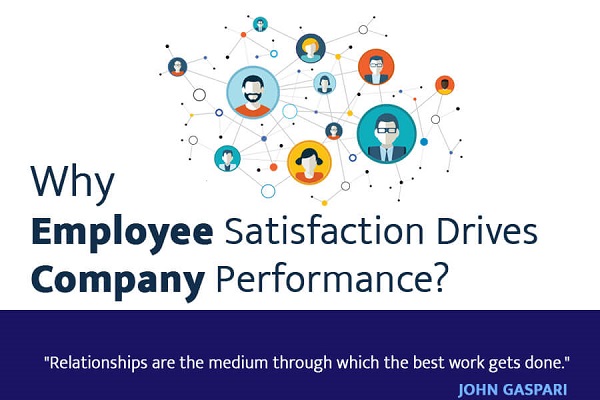The Undervalued Asset: How Middle Management Drives Company Performance And Employee Satisfaction

Table of Contents
Middle Management as a Bridge Between Leadership and Employees
Middle managers occupy a unique position within an organization's structure. They are the critical link, translating the overarching vision and strategies established by senior leadership into actionable goals and tasks for their teams. This translation process requires exceptional communication skills and a deep understanding of both the company's objectives and the capabilities of their individual team members. Effective middle management ensures that everyone is working toward the same goals, reducing confusion and increasing efficiency.
- Improved Communication Channels: Regular team meetings, transparent reporting systems, and open-door policies foster a culture of clear communication, ensuring that everyone is informed and aligned.
- Effective Feedback Mechanisms: Implementing robust performance reviews, 360-degree feedback systems, and regular check-ins enables middle managers to provide constructive feedback, identify areas for improvement, and celebrate successes.
- Clear Articulation of Company Goals: Breaking down complex company-wide strategies into manageable, team-specific goals allows middle managers to empower their teams and drive progress.
- Conflict Resolution and Mediation: Middle managers often act as mediators, resolving conflicts within their teams and facilitating constructive communication between teams and upper management. This prevents minor issues from escalating into major problems.
Boosting Employee Engagement and Satisfaction Through Effective Middle Management
Supportive and empowering middle management styles are directly linked to higher levels of employee engagement and satisfaction. When middle managers create a positive and inclusive work environment, employees feel valued, respected, and motivated to contribute their best work. This extends beyond simple task management; it encompasses mentorship, coaching, and opportunities for professional development.
- Mentoring Programs: Investing in mentorship programs allows experienced middle managers to guide and support the growth of their team members, fostering a culture of continuous learning and development.
- Recognition and Reward Systems: Implementing effective recognition and reward systems—acknowledging individual and team achievements—demonstrates appreciation and boosts morale.
- Focus on Employee Well-being: Prioritizing employee well-being and work-life balance fosters a healthy and productive work environment. Middle managers play a critical role in creating this balance.
- Creating a Positive and Inclusive Work Environment: Middle managers set the tone for their teams, fostering a culture of collaboration, respect, and inclusivity.
- Opportunities for Skill Development and Advancement: Providing opportunities for skill development and career advancement demonstrates investment in employees, increasing motivation and retention.
Driving Company Performance Through Middle Management Excellence
The impact of effective middle management extends directly to a company's key performance indicators (KPIs). Strong middle management fosters a collaborative, innovative, and efficient work environment, directly resulting in improved productivity and profitability.
- Improved Project Management and Task Delegation: Effective middle managers excel at project management, delegating tasks effectively, and ensuring that projects are completed on time and within budget.
- Enhanced Team Productivity and Efficiency: By fostering a culture of collaboration and efficiency, middle managers unlock the full potential of their teams, leading to increased productivity.
- Increased Innovation and Creativity: Empowering teams to think creatively and take calculated risks fosters innovation, leading to new products, services, and processes.
- Better Problem-Solving and Decision-Making: Effective middle managers guide their teams in problem-solving and decision-making, enabling quicker responses to challenges and opportunities.
- Stronger Alignment Between Team Goals and Overall Company Strategy: Middle managers ensure that team goals are aligned with the overall company strategy, creating a unified and focused approach.
Identifying and Developing High-Performing Middle Managers
Investing in the development of high-performing middle managers is crucial for long-term success. This involves identifying existing talent, providing targeted training, and creating clear career progression pathways.
- Leadership Training Programs: Investing in leadership training programs equips middle managers with the skills and knowledge to effectively lead and motivate their teams.
- Mentorship Programs for Aspiring Middle Managers: Providing mentorship opportunities for aspiring middle managers helps them develop essential leadership skills and navigate their career progression.
- Succession Planning: Implementing a robust succession planning process helps identify and develop future leaders within the middle management ranks.
- Performance Management Systems Focused on Development and Growth: Performance management systems should focus not only on evaluation but also on providing opportunities for growth and development.
- 360-Degree Feedback for Self-Assessment and Improvement: Utilizing 360-degree feedback provides valuable insights into leadership styles and allows for targeted self-improvement.
Conclusion: Investing in Middle Management for Sustainable Success
In conclusion, effective middle management is not just a component of a successful organization; it's a critical driver of both employee satisfaction and company performance. Investing in developing strong middle management is not an expense but a strategic investment that yields significant returns. By fostering clear communication, empowering employees, and providing opportunities for growth, organizations can unlock the full potential of their middle management, leading to increased productivity, higher employee retention, and sustainable success. Don't undervalue the power of strong middle management; invest in their development for lasting success. Invest in your middle management today and unlock the full potential of your organization.

Featured Posts
-
 Pha An Vu Bao Hanh Tre O Tien Giang Loi Khai Cua Bao Mau
May 09, 2025
Pha An Vu Bao Hanh Tre O Tien Giang Loi Khai Cua Bao Mau
May 09, 2025 -
 Statement From Williams Regarding Doohan In Light Of Colapinto Links
May 09, 2025
Statement From Williams Regarding Doohan In Light Of Colapinto Links
May 09, 2025 -
 10 Adn Pas Selangor Bantu Mangsa Tragedi Putra Heights Bantuan And Sokongan Dihulurkan
May 09, 2025
10 Adn Pas Selangor Bantu Mangsa Tragedi Putra Heights Bantuan And Sokongan Dihulurkan
May 09, 2025 -
 Anchorage Welcomes Candle Studio Alaska Airlines Lounge Korean Bbq And Eye Tooth Restaurant
May 09, 2025
Anchorage Welcomes Candle Studio Alaska Airlines Lounge Korean Bbq And Eye Tooth Restaurant
May 09, 2025 -
 Stephen King Compares Stranger Things To It Key Similarities And Differences
May 09, 2025
Stephen King Compares Stranger Things To It Key Similarities And Differences
May 09, 2025
Latest Posts
-
 Two Pedestrians Dead After Being Struck By Driver In Elizabeth City
May 09, 2025
Two Pedestrians Dead After Being Struck By Driver In Elizabeth City
May 09, 2025 -
 Elizabeth City Road Fatal Pedestrian Accident Claims Two Lives
May 09, 2025
Elizabeth City Road Fatal Pedestrian Accident Claims Two Lives
May 09, 2025 -
 Driver Kills Two Pedestrians In Elizabeth City Road Accident
May 09, 2025
Driver Kills Two Pedestrians In Elizabeth City Road Accident
May 09, 2025 -
 Navigating The Elizabeth Line A Guide For Wheelchair Users
May 09, 2025
Navigating The Elizabeth Line A Guide For Wheelchair Users
May 09, 2025 -
 Inside The Reimagined Queen Elizabeth 2 A 2 000 Guest Cruise Ship
May 09, 2025
Inside The Reimagined Queen Elizabeth 2 A 2 000 Guest Cruise Ship
May 09, 2025
